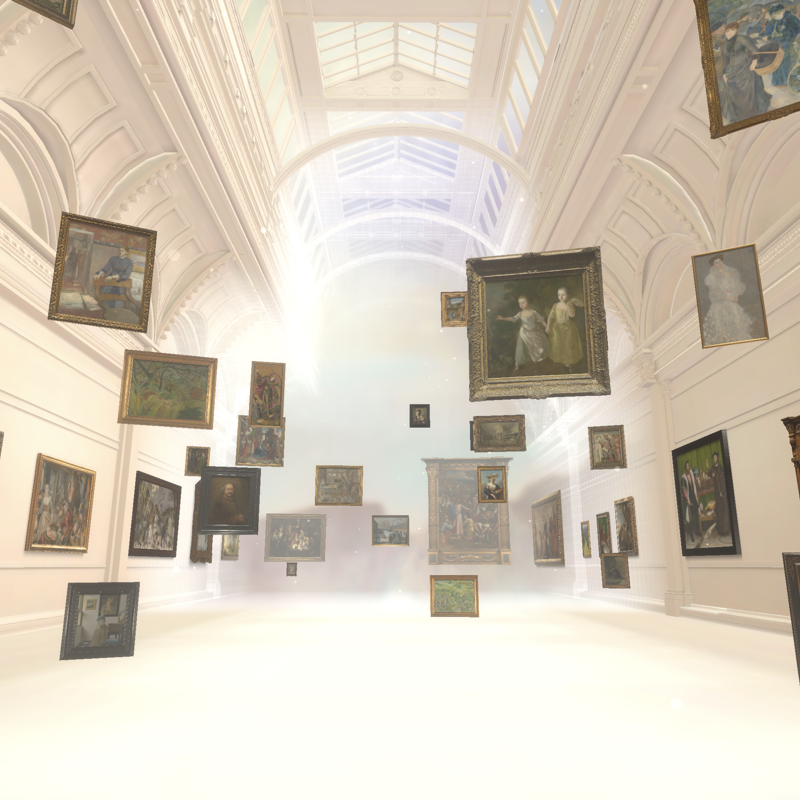Canaletto, 'London: Interior of the Rotunda at Ranelagh', 1754
About the work
Overview
This painting shows the inside of the famous rotunda (demolished in 1805) at Ranelagh Gardens in Chelsea. Ranelegh opened in 1742 as one of London’s most prestigious pleasure gardens, and its main attraction was this vast circular building in which fashionable society could attend balls and listen to music.
To the right, an orchestra performs, catching the attention of a small crowd. We look down on the elegant clientele, which, along with the light that floods the space, emphasises the building’s loftiness. Canaletto’s theatrical lighting highlights the curvature of the building and sparkles on the delicate chandeliers. We aren't just watching the concert – we watch the men, women and children scattered across an enormous stage.
Canaletto painted this work in 1754, towards the end of his nine years in England. He had dominated the London market for view paintings – no other artist, native or foreign, could compare to him.
Key facts
Details
- Full title
- London: Interior of the Rotunda at Ranelagh
- Artist
- Canaletto
- Artist dates
- 1697 - 1768
- Date made
- 1754
- Medium and support
- oil on canvas
- Dimensions
- 47 × 75.6 cm
- Acquisition credit
- Bought, 1894
- Inventory number
- NG1429
- Location
- Room 37
- Collection
- Main Collection
- Frame
- 19th-century English Frame
Provenance
Additional information
Text extracted from the ‘Provenance’ section of the catalogue entry in Michael Levey, ‘National Gallery Catalogues: The Seventeenth and Eighteenth Century Italian Schools’, London 1986; for further information, see the full catalogue entry.
Exhibition history
-
2012Garden Open Today: 300 Years of Garden VisitingGarden Museum23 April 2012 - 24 June 2012
Bibliography
-
1809A Catalogue of Some Marbles….at the Hyde, Near Ingatestone, Essex: The Greater Part Successively the Property of T.H… and Now of J.D, London 1809
-
1899H. Horne, 'An Inquiry into Two Pictures Recently Acquired for the National Gallery', Magazine of Art, 1899, pp. 241-6
-
1920H.F. Finberg, 'Canaletto in England', The Walpole Society, IX, 1921, pp. 41-4
-
1923W.G. Constable, 'Some Unpublished Canalettos', The Burlington Magazine, XLII, 1923, pp. 278-8
-
1927E. Panofsky, 'Die Perspective als symbolische Form', in Vorträge der Bibliothek Warburg, Leipzig 1927, pp. 258-330
-
1949A.C. Sewter, 'Another English Canaletto', The Burlington Magazine, 1949
-
1954V. Moschini, Canaletto. Testo di Vittorio Moschini, Milan 1954
-
1954F.J.B. Watson, Canaletto, revised edn, London 1954
-
1956Levey, Michael, National Gallery Catalogues: The Eighteenth Century Italian Schools, London 1956
-
1971M. Levey, The Seventeenth and Eighteenth Century Italian Schools, London 1971
-
1974A. Corboz, 'Sur la prétendue objectivité de Canaletto', Arte veneta, XXVIII, 1974, pp. 205-18
-
1976W.G. Constable and J.G. Links, Canaletto: Giovanni Antonio Canal, 1697-1768, revised edn, Oxford 1976
-
1977J.G. Links, Canaletto and His Patrons, London 1977
-
1982T.V. Doria et al., Canaletto. Disegni - Dipinti - Incisioni (exh. cat. Fondazione Giorgio Cini, San Giorgio Maggiore, 25 July - 17 October 1982), Venice 1982
-
1985A. Corboz, Canaletto: Una Venezia immaginaria, Milan 1985
-
1986Levey, Michael, National Gallery Catalogues: The Seventeenth and Eighteenth Century Italian Schools, London 1986
-
1987M. Warner, The Image of London: Views by Travellers and Emigrés 1550-1920 (exh. cat. Barbican Art Gallery, 6 August - 18 October 1987), London 1987
-
1989W.G. Constable and J.G. Links, Canaletto: Giovanni Antonio Canal, 1697-1768, 3rd edn, Oxford 1989
-
1989K. Baetjer and J.G. Links, Canaletto, (exh. cat. Metropolitan Museum of Art, 30 October 1989 - 21 January 1990), New York 1989
-
1992G. Beard, The Complete Gentleman: Five Centuries of Aristocratic Life, New York 1992
-
1993J.H. Whitfield, The Englishness of Canaletto, Birmingham 1993
-
1993M. Liversidge and J. Farrington, Canaletto and England, (exh. cat. Birmingham CMuseum and Art Gallery, 14 October 1993 - 9 January 1994), Birmingham 1993
-
1994J.G. Links, Canaletto, revised edn, London 1994
-
2001
C. Baker and T. Henry, The National Gallery: Complete Illustrated Catalogue, London 2001
About this record
If you know more about this painting or have spotted an error, please contact us. Please note that exhibition histories are listed from 2009 onwards. Bibliographies may not be complete; more comprehensive information is available in the National Gallery Library.


















